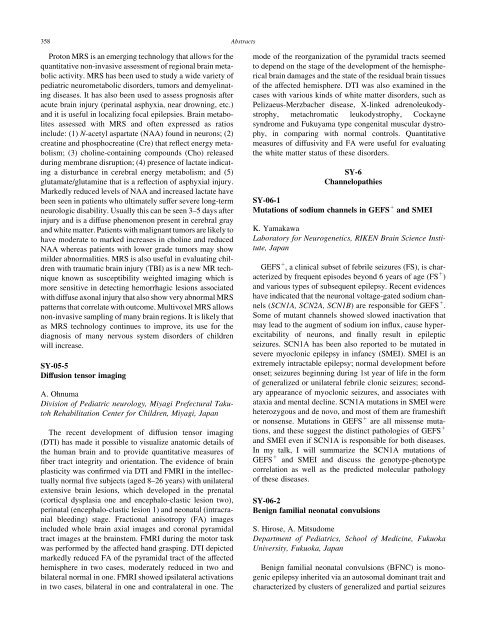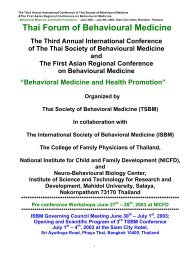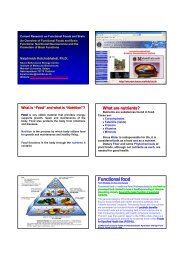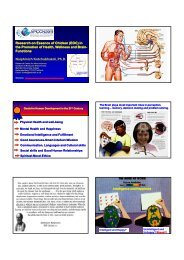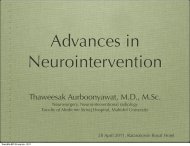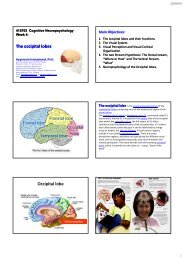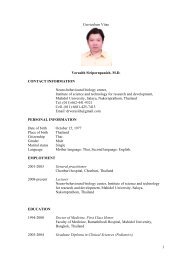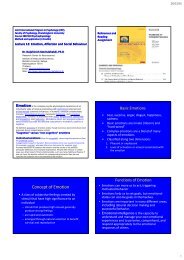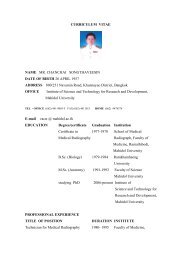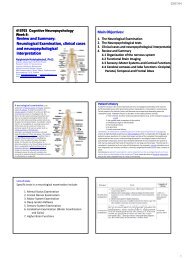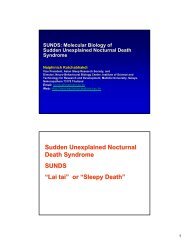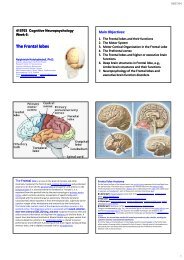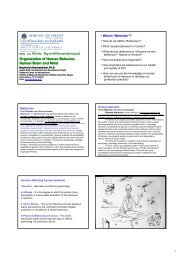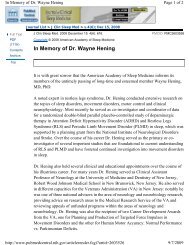PDF File - Mahidol University
PDF File - Mahidol University
PDF File - Mahidol University
You also want an ePaper? Increase the reach of your titles
YUMPU automatically turns print PDFs into web optimized ePapers that Google loves.
358<br />
Abstracts<br />
Proton MRS is an emerging technology that allows for the<br />
quantitative non-invasive assessment of regional brain metabolic<br />
activity. MRS has been used to study a wide variety of<br />
pediatric neurometabolic disorders, tumors and demyelinating<br />
diseases. It has also been used to assess prognosis after<br />
acute brain injury (perinatal asphyxia, near drowning, etc.)<br />
and it is useful in localizing focal epilepsies. Brain metabolites<br />
assessed with MRS and often expressed as ratios<br />
include: (1) N-acetyl aspartate (NAA) found in neurons; (2)<br />
creatine and phosphocreatine (Cre) that reflect energy metabolism;<br />
(3) choline-containing compounds (Cho) released<br />
during membrane disruption; (4) presence of lactate indicating<br />
a disturbance in cerebral energy metabolism; and (5)<br />
glutamate/glutamine that is a reflection of asphyxial injury.<br />
Markedly reduced levels of NAA and increased lactate have<br />
been seen in patients who ultimately suffer severe long-term<br />
neurologic disability. Usually this can be seen 3–5 days after<br />
injury and is a diffuse phenomenon present in cerebral gray<br />
and white matter. Patients with malignant tumors are likely to<br />
have moderate to marked increases in choline and reduced<br />
NAA whereas patients with lower grade tumors may show<br />
milder abnormalities. MRS is also useful in evaluating children<br />
with traumatic brain injury (TBI) as is a new MR technique<br />
known as susceptibility weighted imaging which is<br />
more sensitive in detecting hemorrhagic lesions associated<br />
with diffuse axonal injury that also show very abnormal MRS<br />
patterns that correlate with outcome. Multivoxel MRS allows<br />
non-invasive sampling of many brain regions. It is likely that<br />
as MRS technology continues to improve, its use for the<br />
diagnosis of many nervous system disorders of children<br />
will increase.<br />
SY-05-5<br />
Diffusion tensor imaging<br />
A. Ohnuma<br />
Division of Pediatric neurology, Miyagi Prefectural Takutoh<br />
Rehabilitation Center for Children, Miyagi, Japan<br />
The recent development of diffusion tensor imaging<br />
(DTI) has made it possible to visualize anatomic details of<br />
the human brain and to provide quantitative measures of<br />
fiber tract integrity and orientation. The evidence of brain<br />
plasticity was confirmed via DTI and FMRI in the intellectually<br />
normal five subjects (aged 8–26 years) with unilateral<br />
extensive brain lesions, which developed in the prenatal<br />
(cortical dysplasia one and encephalo-clastic lesion two),<br />
perinatal (encephalo-clastic lesion 1) and neonatal (intracranial<br />
bleeding) stage. Fractional anisotropy (FA) images<br />
included whole brain axial images and coronal pyramidal<br />
tract images at the brainstem. FMRI during the motor task<br />
was performed by the affected hand grasping. DTI depicted<br />
markedly reduced FA of the pyramidal tract of the affected<br />
hemisphere in two cases, moderately reduced in two and<br />
bilateral normal in one. FMRI showed ipsilateral activations<br />
in two cases, bilateral in one and contralateral in one. The<br />
mode of the reorganization of the pyramidal tracts seemed<br />
to depend on the stage of the development of the hemispherical<br />
brain damages and the state of the residual brain tissues<br />
of the affected hemisphere. DTI was also examined in the<br />
cases with various kinds of white matter disorders, such as<br />
Pelizaeus-Merzbacher disease, X-linked adrenoleukodystrophy,<br />
metachromatic leukodystrophy, Cockayne<br />
syndrome and Fukuyama type congenital muscular dystrophy,<br />
in comparing with normal controls. Quantitative<br />
measures of diffusivity and FA were useful for evaluating<br />
the white matter status of these disorders.<br />
SY-6<br />
Channelopathies<br />
SY-06-1<br />
Mutations of sodium channels in GEFS 1 and SMEI<br />
K. Yamakawa<br />
Laboratory for Neurogenetics, RIKEN Brain Science Institute,<br />
Japan<br />
GEFS 1 , a clinical subset of febrile seizures (FS), is characterized<br />
by frequent episodes beyond 6 years of age (FS 1 )<br />
and various types of subsequent epilepsy. Recent evidences<br />
have indicated that the neuronal voltage-gated sodium channels<br />
(SCN1A, SCN2A, SCN1B) are responsible for GEFS 1 .<br />
Some of mutant channels showed slowed inactivation that<br />
may lead to the augment of sodium ion influx, cause hyperexcitability<br />
of neurons, and finally result in epileptic<br />
seizures. SCN1A has been also reported to be mutated in<br />
severe myoclonic epilepsy in infancy (SMEI). SMEI is an<br />
extremely intractable epilepsy; normal development before<br />
onset; seizures beginning during 1st year of life in the form<br />
of generalized or unilateral febrile clonic seizures; secondary<br />
appearance of myoclonic seizures, and associates with<br />
ataxia and mental decline. SCN1A mutations in SMEI were<br />
heterozygous and de novo, and most of them are frameshift<br />
or nonsense. Mutations in GEFS 1 are all missense mutations,<br />
and these suggest the distinct pathologies of GEFS 1<br />
and SMEI even if SCN1A is responsible for both diseases.<br />
In my talk, I will summarize the SCN1A mutations of<br />
GEFS 1 and SMEI and discuss the genotype-phenotype<br />
correlation as well as the predicted molecular pathology<br />
of these diseases.<br />
SY-06-2<br />
Benign familial neonatal convulsions<br />
S. Hirose, A. Mitsudome<br />
Department of Pediatrics, School of Medicine, Fukuoka<br />
<strong>University</strong>, Fukuoka, Japan<br />
Benign familial neonatal convulsions (BFNC) is monogenic<br />
epilepsy inherited via an autosomal dominant trait and<br />
characterized by clusters of generalized and partial seizures


